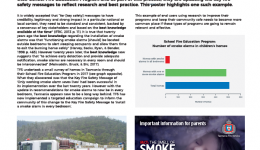Lead end user
Children represent the most vulnerable demographic group in disasters – across the globe it is estimated that 30-50% of fatalities are children - while they are also most vulnerable to psychosocial impacts. Early research indicates that children are a resource for reducing current disaster risks and can also mitigate future risks.
The role of children’s disaster education in managing risk has been recognised as a major priority in the federal government’s National Strategy for Disaster Resilience. Yet, despite a recent surge in child-centred disaster research, the social, psychological, economic and political mechanisms that enable children to both understand and take action to reduce disaster risk remain largely unexplored and the evidence-base for best-practice remains limited.
This project is conducting a nationwide evaluation of programs and strategies based on a child-centred disaster risk reduction framework. It will develop cost-effective programs that reduce the risk and increase resilience for children, schools, households and communities.
During a disaster responsibility for animals lies with the owner. However, owners are often ill-prepared for themselves and their animals, which can lead to people risking their lives by failing to evacuate or evacuating too late, which endangers both human and animal lives. This recognition that animals need to be considered and integrated into emergency management and disaster preparedness, response, and recovery poses additional challenges for traditional responding. Extra preparation, knowledge and skills are required to ensure the safety of animals, their owners, and responders.
In this context, animal emergency management has emerged as a relatively new area, with a more complex and often less experienced set of stakeholders requiring integration and coordination.
This study addressed the lack of Australian research by identifying challenges for end-users and studying the disaster experiences of animal owners and responders. Subsequent publications have led to an extended knowledge base, and identification of best practice approaches.
The increasing frequency and complexity of natural hazards poses a challenge for community resilience. Communication and education of risk mitigation strategies play an essential role in building and maintaining resilience through preparation and planning by residents.
This project combined expertise in communication, social and consumer psychology, and disaster and emergency management. It identified barriers and enablers in residents’ decision making, preparing, and planning by examining residents’ intended use of different types of triggers for action during hazards. This included when to start evacuating and what information source to use, with the aim of trying to understand why some residents form a better-quality household plan with safer intended triggers than other residents.
This project developed an index of the current state of disaster resilience in Australian communities – the Australian Disaster Resilience Index. The Index is a tool for assessing the resilience of communities to natural hazards at a large scale and is designed to provide input into macro-level policy, strategic planning and community engagement activities at national, state and local government levels.
Deliverables include the development of disaster resilience indicators, maps of disaster resilience at multiples scales, a State of Disaster Resilience Report, and examples that use the Index in a natural hazard resilience planning context.




